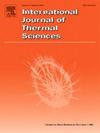Exploration of PCM melting in a heated enclosure with vertical plate fins: Experimental analysis
IF 4.9
2区 工程技术
Q1 ENGINEERING, MECHANICAL
International Journal of Thermal Sciences
Pub Date : 2025-03-21
DOI:10.1016/j.ijthermalsci.2025.109884
引用次数: 0
Abstract
This study investigates the enhancement of thermal performance in phase change materials (PCMs) through the application of fins. PCMs are renowned for their ability to store energy with minimal temperature fluctuations, rendering them valuable in thermal energy storage systems. However, their low thermal conductivity constrains heat transfer efficiency. By increasing the surface area, fins can enhance convective heat transfer and offer a solution to this limitation. The research conducts experimental analyses on the efficacy of vertical fins within an enclosure heated by a single vertical wall, emphasizing their influence on PCM thermal performance. Melt fronts are monitored at various time intervals, and local temperatures are recorded at nine specific points. The study explores three types of fins: non-perforated fins, circular-perforated fins, and fins with oval cuts. The findings demonstrate a significant improvement in PCM heat transfer rates and thermal behavior with the incorporation of fins, effectively lowering temperatures in proximity to the heat source. Specifically, the inclusion of 1, 3, and 5 non-perforated fins results in reductions of PCM melting times by 13 %, 32 %, and 39 %, respectively. The maximum melting rates for the cases with 5, 3, and 1 non-perforated fins are approximately 133 %, 90 %, and 22 % higher, respectively, compared to the case without fins. Furthermore, the research identifies an efficient fin design with oval cuts, achieving the shortest melting time while remaining cost-effective and lightweight. This indicates that the melting rate in the final stage of the melting process for this design is higher than in the other cases. This design features 30 % less surface area and 40 % less weight than complete fins, making it an attractive option for thermal systems.
求助全文
约1分钟内获得全文
求助全文
来源期刊

International Journal of Thermal Sciences
工程技术-工程:机械
CiteScore
8.10
自引率
11.10%
发文量
531
审稿时长
55 days
期刊介绍:
The International Journal of Thermal Sciences is a journal devoted to the publication of fundamental studies on the physics of transfer processes in general, with an emphasis on thermal aspects and also applied research on various processes, energy systems and the environment. Articles are published in English and French, and are subject to peer review.
The fundamental subjects considered within the scope of the journal are:
* Heat and relevant mass transfer at all scales (nano, micro and macro) and in all types of material (heterogeneous, composites, biological,...) and fluid flow
* Forced, natural or mixed convection in reactive or non-reactive media
* Single or multi–phase fluid flow with or without phase change
* Near–and far–field radiative heat transfer
* Combined modes of heat transfer in complex systems (for example, plasmas, biological, geological,...)
* Multiscale modelling
The applied research topics include:
* Heat exchangers, heat pipes, cooling processes
* Transport phenomena taking place in industrial processes (chemical, food and agricultural, metallurgical, space and aeronautical, automobile industries)
* Nano–and micro–technology for energy, space, biosystems and devices
* Heat transport analysis in advanced systems
* Impact of energy–related processes on environment, and emerging energy systems
The study of thermophysical properties of materials and fluids, thermal measurement techniques, inverse methods, and the developments of experimental methods are within the scope of the International Journal of Thermal Sciences which also covers the modelling, and numerical methods applied to thermal transfer.
 求助内容:
求助内容: 应助结果提醒方式:
应助结果提醒方式:


